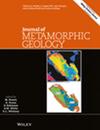Comparison of Water Contents Between Ultrahigh-Pressure Oceanic and Continental Eclogites From the North Qaidam Orogen
Abstract
Water storage and transport in eclogite are critical for the water cycle in subduction zones. A combined study of the petrology and water contents of nominally anhydrous minerals (NAMs) was carried out on oceanic and continental eclogites from the North Qaidam orogen. The results are used to compare the presence, abundance and behaviour of free fluids of subducting mafic crust at subarc depths between oceanic and continental subduction zones and to further investigate the water storage and transport in subducting mafic crust with respect to the geothermal gradients of subduction zones. Both oceanic and continental eclogites experienced Alpine-type ultrahigh-pressure (UHP) metamorphism with similar P–T paths. The hydrogen incorporation of OH− modes at 3450–3470 and 3600–3630 cm−1 in omphacite is controlled by the classical mechanism (H++Al3+ → Si4+). The OH− mode at 3510–3540 cm−1 in omphacite is mainly controlled by the Ca and Na contents at the M2 site. The primary structural water content of garnet is positively correlated with temperature, indicating that temperature plays an important role in hydrogen incorporation into garnet during the high-pressure (HP) to UHP metamorphic transition. In contrast, the water content of omphacite does not differ between HP and UHP eclogite-facies conditions. This observation suggests different hydrogen incorporation between garnet and omphacite in response to P–T changes. Garnet and omphacite in oceanic and continental eclogites exhibit similar primary structural water contents under UHP conditions, indicating that the subducting mafic crust in the oceanic and continental subduction zones experienced similar water storage and transport during the HP-to-UHP metamorphic transition despite their different protolith natures. The eclogites that experienced different P–T paths exhibited different water contents under HP and UHP conditions, indicating that water storage and transport in the subducting mafic crust are controlled by the geothermal gradients of subduction zones rather than by the protoliths. An elevated thermal gradient enhances the decomposition of hydrous minerals and the incorporation of hydrogen into NAMs. A large amount of water is released from the subducting mafic crust during prograde Alpine-type HP eclogite-facies metamorphism, resulting in less water left to be released during further Alpine-type HP-to-UHP eclogite-facies transitions.

 求助内容:
求助内容: 应助结果提醒方式:
应助结果提醒方式:


